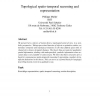Free Online Productivity Tools
i2Speak
i2Symbol
i2OCR
iTex2Img
iWeb2Print
iWeb2Shot
i2Type
iPdf2Split
iPdf2Merge
i2Bopomofo
i2Arabic
i2Style
i2Image
i2PDF
iLatex2Rtf
Sci2ools
110
click to vote
CI
2002
2002
Topological Spatio-Temporal Reasoning and Representation
We present here a theory of motion from a topological point of view, in a symbolic perspective. Taking space-time histories of objects as primitive entities, we introduce temporal and topological relations on the thus defined space-time to characterize classes of spatial changes. The theory thus accounts for qualitative spatial information, dealing with underspecified, symbolic information when accurate data is not available or unnecessary. We show that these structures give a basis for commonsense spatio-temporal reasoning by presenting a number of significant deductions in the theory. This can serve as a formal basis for languages describing motion events in a qualitative way. Topic Knowledge representation, spatio-temporal reasoning, motion description. 1
CI 2002 | Commonsense Spatio-temporal Reasoning | Qualitative Spatial Information | Spatio-temporal Reasoning |
Related Content
| Added | 17 Dec 2010 |
| Updated | 17 Dec 2010 |
| Type | Journal |
| Year | 2002 |
| Where | CI |
| Authors | Philippe Muller |
Comments (0)

